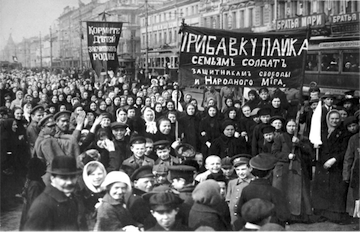This section covers the events from February to July 1917. In it we will be asking why and how the protests against shortages of bread turned into a full-scale revolution in February 1917? How did people react to the downfall of the Tsar? What were the aims of the Provsional Government and the Soviet? How did their Dual Power system work in the spring of 1917? How far did either represent the hopes and expectations of the peasants, workers, national minorities, sailor and soldiers? How should we account for the popular appeal of Lenin's April Theses among those who rallied to the Bolsheviks? And why did the authority of the Provisional Government collpase so quickly in the summer months of 1917? You will find some answers to these question in this sectiom, which also contains extracts from my books and photographs from 1917. Register here to get information on accessing more materials including my responses to exam questions on these themes.

Demonstration in St Petersburg, International Women's Day, 23 February 1917
Today the Russian Revolution is linked in people's minds to the events of October 1917. But the Bolshevik seizure of power was a coup d'état which depended on the social forces unleashed by the February Revolution, the real revolution of 1917.
On 23 February, International Women's Day, a large crowd of women marched along Nevsky Prospekt to protest for equal rights. Read more...
...although their rank and file were present in the crowds, the socialist leaders were quite unprepared to take on this role. Read more...
On 27 February a large crowd came to the Tauride Palace - the seat of the Duma - looking for political leaders. Following the precedent of 1905, a Petrograd Soviet of workers' and soldiers' deputies was elected. Read more...
Nicholas agreed to abdicate not only for himself but for his son in favour of the Grand Duke Mikhail, but when this was announced there were further demonstrations calling for the downfall of the monarchy, and Mikhail was persuaded to step down. Read more...
In the absence of any obvious counter-revolution - without a real enemy to fight against - the destruction of the symbols of the old regime was, at least for the revolutionaries, the destruction of the old regime itself. Read more...
Led by Prince Lvov, the Provisional Government contained just one socialist, the Minister of Justice, Alexander Kerensky. Read more...
The revolution of 1917 was part of a general crisis of authority. There was a rejection of not just the state but of all figures of authority: judges, policemen, government officials, army and navy officers, priests, teachers, employers, landowners, village elders, patriarchal fathers and husbands. There were lots of revolutions going on. Read more...
Lenin returned to Russia on a sealed train provided by the Germans, who were hoping his defeatist views would undermine the Russian war effort. He arrived in Petrograd on 3 April with a ten-point programme - his April Theses - for a second revolution based on giving power to the Soviets. Read more...
The collapse of the offensive dealt a fatal blow to the authority of the Provisional Government. The coalition fell apart and there was a 3-week interregnum while the Socialists and liberals (Kadets) tried to patch together another government, during which there was a vacuum of power. This was the context of the July uprising. Read more...
This was one of the most revealing scenes of the whole revolution - one of those rare episodes when the hidden relations of power are illuminated on the surface of events and the broader course of history becomes clear Read more...
These images tell us about popular aspirations in 1917. Read more...
Here are some exam-like questions. Read more...
A recording of a lecture/class using primary documents. Read more...
A list of further reading. Read more...

